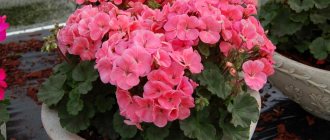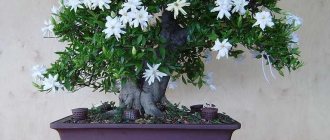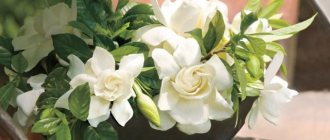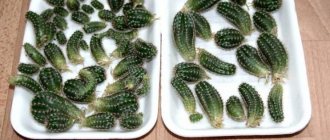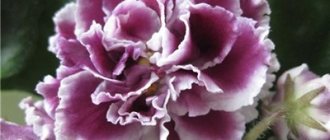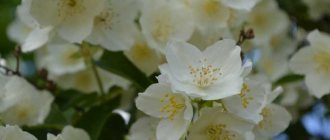Proper care of a flower is of paramount importance, since not only its appearance, but also its general condition depends on it. Caring for gardenia is even more painstaking work, since it is very demanding of the environment.
The gardenia plant is a popular houseplant that dates back to the 18th century. Botanists know about 134 species of gardenias, but the most popular among gardeners are Gardenia jasmine and Gardenia Tahitian. The gardenia flower has a delicate white corolla and can grow up to 1.5 meters in height.
Gardenia grows at home only if all the necessary conditions are present. Homemade hydrangea is much more capricious than wild hydrangea: it is very sensitive to changes in environment and prone to diseases. In our article we will talk about how to care for gardenia, how to create comfortable conditions for its growth and flowering.
Soil for gardenia in a pot
If you decide to plant gardenia at home, then you need to choose the right soil and prepare it for the process of planting the flower.
When choosing soil, you need to pay attention to the following aspects:
Soil type
Gardenia needs acidic soil, so you can mix leaf, coniferous, and turf soil in a 1:1 ratio. It is also necessary to add 1 part of sand and peat soil. In no case should you add lime to the mixture, as this can lead to the death of the flower. If you can’t make soil yourself, purchase soil for azaleas.
pH level
Before planting the plant, you need to check the pH level of the soil. It should be in the range from 4.5 to 5.5.
Transfer
Once every few years, the plant needs to be replanted into a larger container when the previous gardenia pot becomes crowded.
Proper transplantation will benefit the plant - it will grow and develop better. Sometimes, gardenia owners often experience yellowing of leaves and their falling off. If you recently replanted a plant, then most likely you accidentally damaged the root system. To correct the situation, you need to create greenhouse conditions for the gardenia and remove it from direct sunlight.
Priming
You can buy soil with the required composition in a store or make it yourself. The main thing is not to use soil containing lime , which is destructive for the flower. The main condition is increased soil acidity. To prepare the soil yourself, prepare peat moss or other material that acidifies the compost.
What pots are suitable?
The new container should be several centimeters larger than the previous one and have wide holes at the bottom for drainage. The flower can be planted in either a ceramic or plastic pot. However, the latter is more preferable, since during watering it will have to be placed in a basin of water. The plastic container will not be damaged by moisture, but stains will remain on the ceramic pot.
Preparing for transplant
Carefully remove the plant from the pot and inspect the roots. If there are any that are sick or broken, remove them. Place the gardenia in the prepared pot, adjust the flower so that its root neck is underground .
Cover the root mass with soil and tamp down gently to remove any air pockets. After transplanting, immediately water the plant and wait until excess moisture drains into the pan.
Reference . Place the flower where it will receive bright, indirect light. Do not allow foliage to touch the window glass. This can lead to hypothermia of the plant and various diseases.
Replanting after purchase
There is no need to rush to replant the plant immediately after purchase , since the delicate buds may fall off. Wait three to four weeks, and then place the gardenia in another pot with suitable soil.
- Place small pebbles or expanded clay at the bottom of the container, and then fill it with nutritious soil for azaleas or gardenias.
- Remove the plant from the store pot along with a lump of soil and place it in a new container.
After a month and a half, you can feed the gardenia with fertilizers for the first time.
All the secrets of transplanting this beautiful plant are in this video:
How to fertilize gardenia
Fertilizer allows you to replenish a number of useful substances necessary for the growth and development of the flower. If the gardenia is still very young, use mineral or organic fertilizers (such fertilizers must be applied every two weeks). When growing an adult flower, it is best to use fertilizers that do not contain calcium. Gardenias need to be fed with this fertilizer every week. If it happens that the gardenia leaves begin to turn yellow, you can make a weak solution of iron sulfate. It will restore the plant and prevent yellowing of other leaves.
Diseases and pests
Gardenia jasminoides is a capricious plant. Often when growing it, gardeners face a number of problems:
- buds and flowers fall off - low air temperature or the flower pot is moved from place to place;
- the leaves of gardenia jasmine turn yellow - the water for irrigation is not selected correctly, it should be soft and not cold;
- the edges of the leaves darken and dry - the air in the room is too dry, the plant is not watered regularly;
- dark spots on the leaves - too frequent watering, possible rotting of the root system;
- buds fall off - too hot or too cold.
May be attacked by spider mites or scale insects. Insecticides are used to control pests.
Features of care
As already mentioned, gardenia is a flower that is very sensitive to environmental changes, so it is very important to follow the following rules:
Avoid temperature changes in the room where this flower grows
Sudden changes in soil and air temperature can greatly harm gardenia, so you need to ensure that it is constant and within acceptable limits.
Create artificial lighting in winter
Gardenia comes from southern countries, so it constantly needs sunlight. In summer there is enough of it, but in winter it is necessary to compensate for its deficiency so that the gardenia does not wither and continues to bloom. This should only be done if the gardenia begins to fade. Artificial lamps can be used for lighting.
Care for your gardenia regularly
Irregular care of your gardenia can cause it to wilt. For this reason, caring for it should be regular, especially in spring and summer, when it begins to bloom with renewed vigor.
Reproduction
Basically, jasmine gardenia produces offspring thanks to apical cuttings . You can also grow a flower using seeds, but this method is considered more difficult.
Cuttings
- In spring or early autumn, you need to cut ten-centimeter cuttings from the plant.
- They are immediately placed in the ground and covered with a glass jar to create a greenhouse effect.
- When the gardenia gets stronger and takes root, you can transplant it into a permanent pot.
In order for the cutting to take root, plant it in a substrate consisting of seven peat and river sand in equal parts. Before planting, place the cuttings in a weak solution of potassium permanganate , and then dip them in a special root formation stimulator “Kornevin”.
Ventilate cuttings planted in a greenhouse every day and keep the soil moist.
Seeds
This method of growing flowers is considered difficult because the seeds quickly lose their viability. You need to sow in the spring, and the soil will be the same as for cuttings.
- The seeds are covered with a small layer of soil from three to five centimeters, and then pressed a little and sprayed with a spray bottle.
- After this, the container is covered with film or glass and placed in the sunny side.
- In a month, the first shoots will appear, which need to be removed from the sun and continued to be grown in a common container.
Video about the propagation of gardenia jasmine:
Growing methods
There are only two available ways to propagate a flower - cuttings and seeds. But it is believed that the seed method is the most complex and gives almost no results (read about how to grow gardenia from seeds at home). Cuttings are more popular.
ATTENTION : For propagation and planting, you need a special soil mixture of sand, leaf soil, peat, coniferous and turf soil (you can find out what kind of soil is needed for gardenia here). The processes of transplantation and reproduction are similar, but reproduction still has its own characteristics.
We talked in detail about how to prepare the soil and transplant gardenia at home in this article.
Propagation by cuttings
This plant is considered difficult to root. It is more correct to take cuttings during the winter pruning period (late winter - early spring until April). Repeated cuttings are allowed in the summer - before flowering , but no later than in June-July. For cuttings, apical half-lignified cuttings from last year's shoots 8-12 cm long with leaves are suitable.
A suitable substrate for rooting is the same as for rose cuttings. It should be loose, light, airy, permeable to moisture and air. A mixture of sand, turf, and vermiculite is suitable. Coconut fiber and perlite should be used due to the presence of calcium in them. There is an option for rooting cuttings in peat tablets. There are also cases of rooting in water.
The process of planting cuttings:
- The bottom cut should be even and smooth.
- The cutting must be inserted 1-1.5 centimeters into the soil, but the lower leaves should not touch its surface.
- Overly large leaves on cuttings are shortened by a third in order to prevent them from evaporating a lot of moisture. The leaves are not cut off near the uppermost axil; the growth point arises there.
- You need to leave at least a couple of leaves on the cutting so that they nourish the plant until roots appear.
Cuttings that were planted near the side of the bowl are accepted better than others.
Watch a video about propagating gardenia by cuttings:
How to root sprouts?
The rooting process is very slow, at least 3 weeks. But the result is not always success, since for the flower it is important to ensure that the substrate is heated from below, as well as constant temperature support of +24 degrees, or better yet +30. To ensure heating, you can place the substrate in a thermally insulated glass, into which you add hot water, replacing it with heated water from time to time.- Another option for rooting cuttings is to immerse a glass with sprouts in a thermos with hot water for at least 1 week. If the temperature is below +24, then the cuttings can easily rot - they take on a dark color and do not take root.
- Greenhouse conditions will also be indispensable - the plant is placed under a transparent cap to ensure the level of humidity and temperature conditions.
During the rooting period, no air should enter here, so the substrate must immediately be well moistened and the cap hermetically sealed. TIP : You can stimulate the formation of roots by soaking the cuttings in a phytohormonal solution (kornevin, epin, heteroauxin, pennant, zircon). - After 3 weeks, the first young shoots at the top point of growth from the axil of the old leaf will become visible under the bag. After unrolling it (approximately 1 month of rooting), it can be transplanted into regular soil for gardenias.
We use seeds
Another method to propagate gardenia at home is to grow a flower from seeds. Although this is not the most successful and efficient method.
To grow future good plants, you will only need fresh seeds, otherwise they will quickly lose their viability.- If there are fresh seeds, then they need to be soaked first in a growth stimulator. Aloe juice or zircon are most often used. They need to be kept in the solution for 2-3 hours. After this, the seeds are planted through a sieve onto the soil mixture. They are sprinkled on top with soil for azaleas or a mixture of sand, leaf soil, peat, coniferous and turf soil.
- The layer should not exceed 5 mm. Be sure to water the plant, including compaction. In addition, the growing container is covered with glass or film. For germination you need a warm place (+25 degrees), morning ventilation for 1-2 hours every day.
- Shoots will appear no earlier than in 1 month. But if the process occurs in winter, then you should remember that the plant loves light. New shoots need to be illuminated, sprayed and watered.
Watch a video about growing gardenia from seeds:
Main types
In nature, there are up to 250 species of this wonderful plant. However, more popular ornamental crops are used for growing in apartments and gardens.
Jasmine gardenia
This species is most often chosen for growing in apartments, as it adapts perfectly to these conditions. Jasmine gardenia has the appearance of a dense, spreading shrub up to 80 cm high. Glossy dark green leaves with a pointed edge are up to 8 cm long. Flowers that look like roses proudly stand out against their background with their snow-white color. Over time, the petals take on a yellowish tint, so you can immediately find white, cream and yellowish buds on the bush. The most common varieties are:
- — “First Love” with fragrant creamy-white flowers, up to 13 cm in diameter;
- - "Variegata" - distinguished by its green leaves covered with a whitish-marble pattern and white double flowers;
- - “Fortune” - its buds when opened have a diameter of 10 cm.
This species has a second, completely justified name “Regal” due to its decorative effect. It has many other varieties bred through selective breeding, each of which differs in shape, size, color of foliage and buds, as well as flowering duration.
Vietnamese gardenia
This type of gardenia can be a compact tree or a lush spreading bush. The thick cover of leaves has a beautiful shiny surface, and large snow-white flowers with a diameter of up to 8 cm have rather unusual petals that curl into fancy long tubes.
Yellow gardenia
The neat tree has erect stems with glossy green leaves. Initially white buds bloom in the axils of the foliage, which then turn yellow. Over time, the color shift increases from lemon to bright orange.
Gardenia citriodora
A luxurious bush of this type of gardenia has highly branched shoots with oval glossy leaves. Its flowering is fascinating with a mass of small, no more than 2 cm in diameter, white double flowers. The plant also boasts a delicious, intense aroma.
Healing properties
The gardenia flower (we discussed care at home in the article) is not only a beautiful ornamental plant, but also medicinal. Its effectiveness is known in the treatment of stomatitis, dysentery and mastitis. Also, decoctions from its petals successfully help fight diseases of the lungs, kidneys, and intestines.
Following the recommendations of experts when growing this beautiful plant will allow you to admire its magnificent appearance and flowering. Thanks to its amazing beauty, gardenia can be an excellent decoration for absolutely any home.
